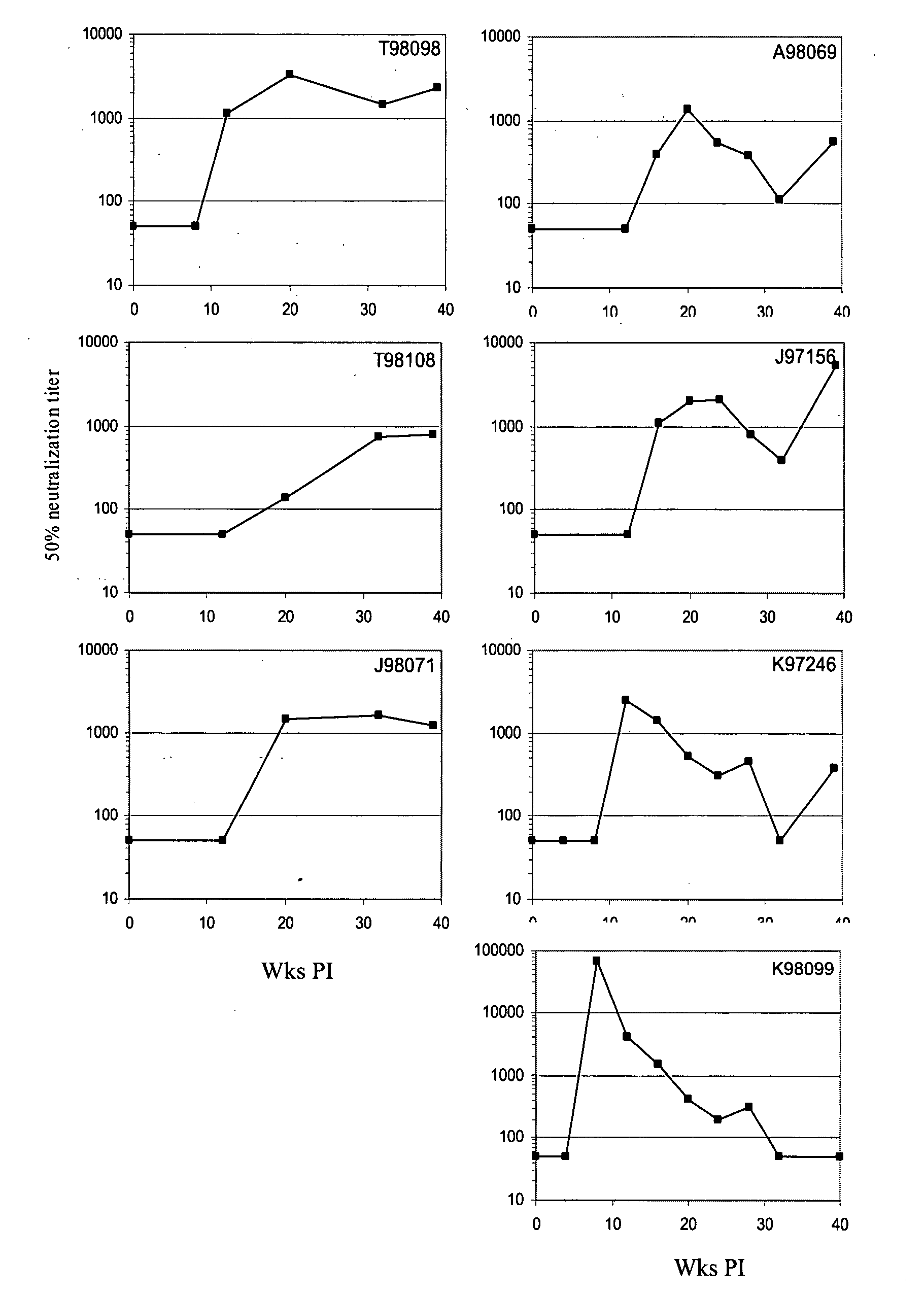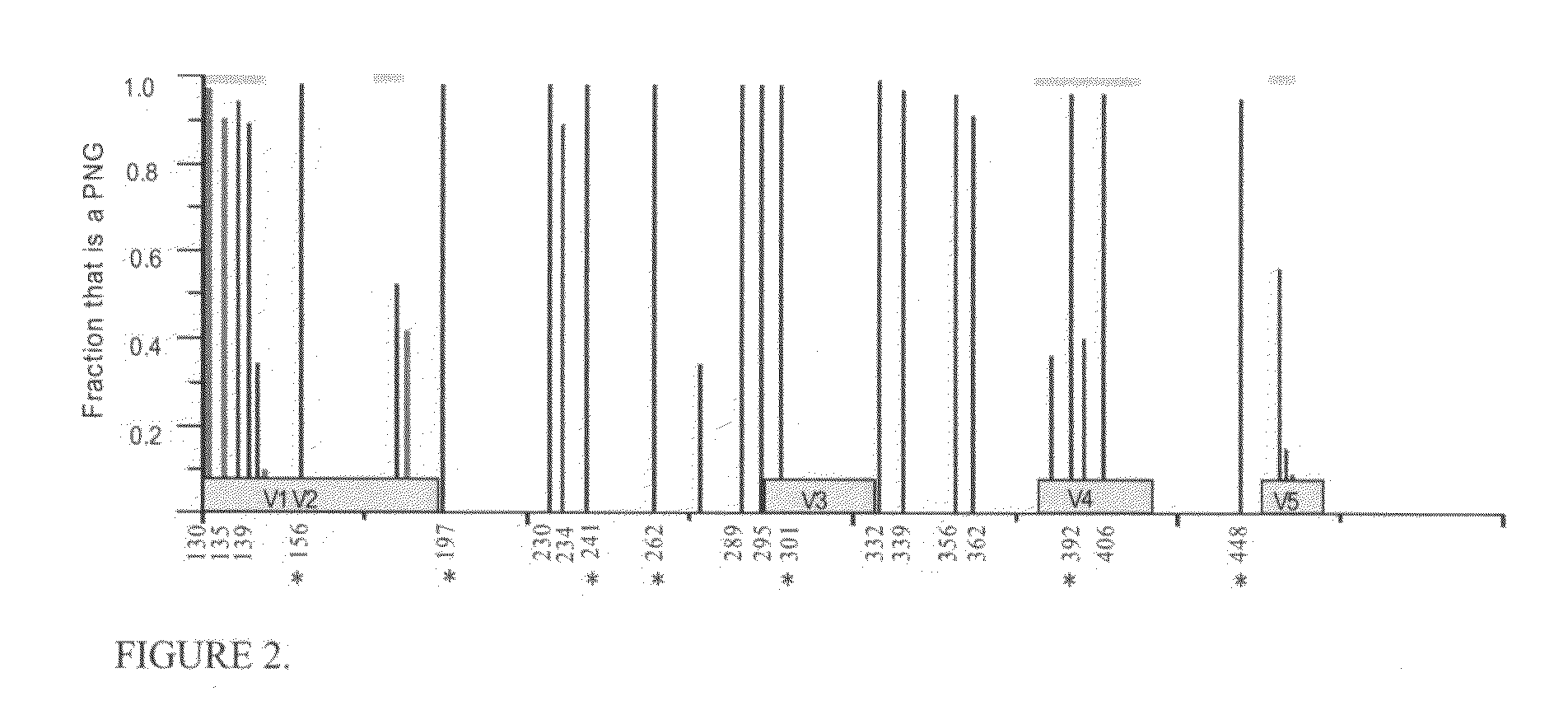AIDS vaccines
a technology of vaccines and anti-hiv, applied in the field of hiv vaccines, can solve the problems of multi-year maturation process, affecting the development of hiv vaccines, and altered tropism, and achieve the effect of increasing acidity
- Summary
- Abstract
- Description
- Claims
- Application Information
AI Technical Summary
Benefits of technology
Problems solved by technology
Method used
Image
Examples
example 1
[0044]This Example describes consistent patterns of change during diversification of the predicted HIV-1 Envelope proteins in SHIV-infected macaques.
1. Methods
[0045]SHIV89.6P challenge stock: SHIV-89.6P bulk culture (provided by Dr. Norman Letvin, Harvard University) was passaged twice through M. nemestrina PBMCs then used to challenge M. nemestrina intrarectally with 50 times the 50% macaque infectious doses (MID50) (Doria-Rose et al. (2003) J. Virol. 77:11563-77). Sequencing of proviral gp120 from the PBMCs used to grow the virus revealed that the consensus sequence was identical to the published sequence SHIV 89.6P KB9 (accession no. U89134) (data not shown).
[0046]PBMC extraction, PCR, cloning and sequencing: All extractions were performed in a separate PCR containment hood using unidirectional workflow, separate storage of templates, primers and other reagents, and other cleaning precautions to avoid sample cross-contamination. DNA was extracted using Qiagen QIAamp DNA Mini Kit ...
example 2
[0074]This Example describes a representative vaccination protocol according to some embodiments of the invention.
[0075]Table 3 provides four examples of combinations of glycosylation mutants that may be used to vaccinate a human host with a series of HIV-1 Env variants in order to optimize the development of homologous and heterologous NAbs. The human host may already infected be with HIV-1, may become infected during the vaccination protocol, or may remain uninfected throughout the entire vaccination protocol. The exact timing of delivery of each component can be varied. In the examples below, only DNA and protein are used. An exemplary regimen for delivery is weeks 0, 12, 20, 32, 34, and 40. The four experimental groups are compared for optimal development of anti-Env immunity: (1) Clonal—Early Env; (2) Clonal—All Changes; (3) Quasispecies Members as Sequential Vaccination; and (4) Quasispecies combination. In Table 3, “Clonal—Early Env” refers to four inoculations, each with a s...
example 3
[0076]This Example describes a representative vaccination protocol according to some embodiments of the invention.
[0077]In this example, the dominant variant that is shown to be an escape mutant from NAbs at the concurrent time of infection is used as the major immunogen for that time point. The human host may already infected be with HIV-1, may become infected during the vaccination protocol, or may remain uninfected throughout the entire vaccination protocol. The exact timing of delivery of each component can be varied. In the examples below, only DNA and protein are used. An exemplary regimen for delivery is weeks 0, 12, 20, 32, 34, and 40.
[0078]While the preferred embodiment of the invention has been illustrated and described, it will be appreciated that various changes can be made therein without departing from the spirit and scope of the invention.
PUM
| Property | Measurement | Unit |
|---|---|---|
| time | aaaaa | aaaaa |
| time | aaaaa | aaaaa |
| volume | aaaaa | aaaaa |
Abstract
Description
Claims
Application Information
 Login to View More
Login to View More - R&D
- Intellectual Property
- Life Sciences
- Materials
- Tech Scout
- Unparalleled Data Quality
- Higher Quality Content
- 60% Fewer Hallucinations
Browse by: Latest US Patents, China's latest patents, Technical Efficacy Thesaurus, Application Domain, Technology Topic, Popular Technical Reports.
© 2025 PatSnap. All rights reserved.Legal|Privacy policy|Modern Slavery Act Transparency Statement|Sitemap|About US| Contact US: help@patsnap.com



